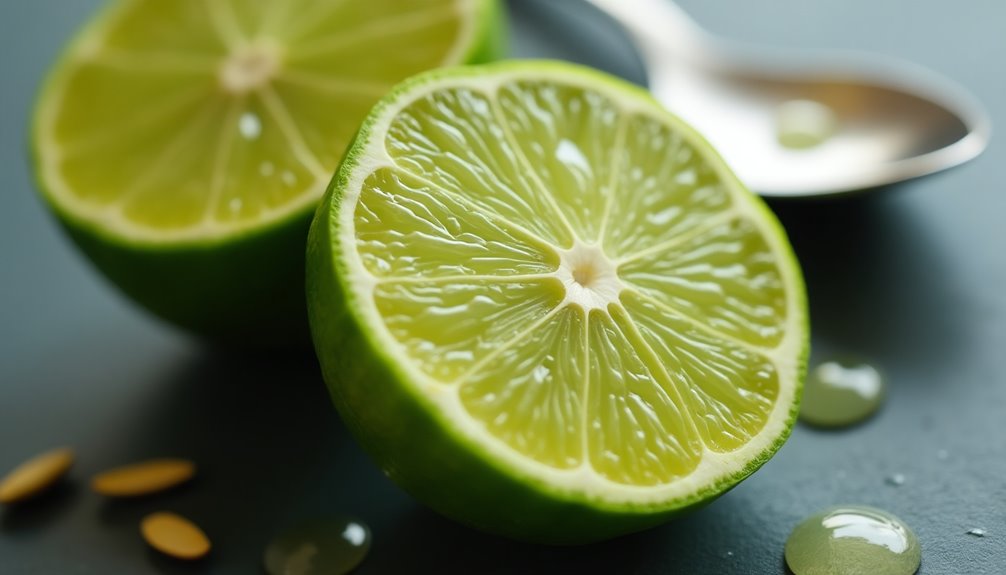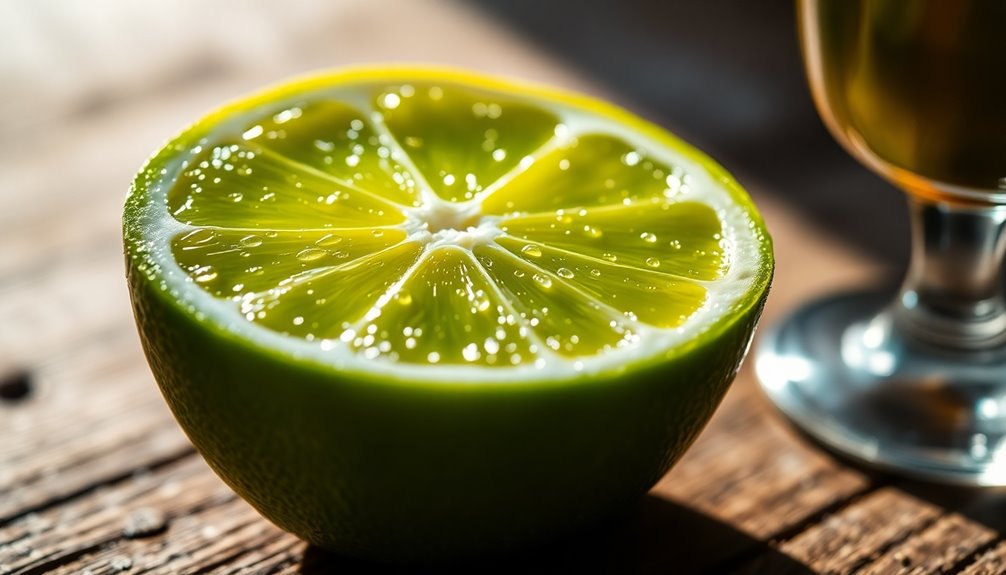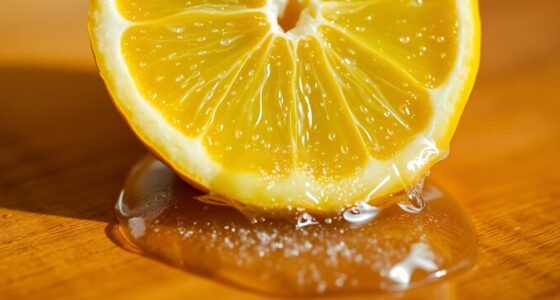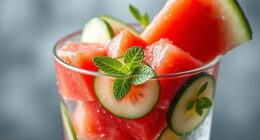A medium lime typically yields about 2 tablespoons, or 1 ounce, of juice. That's a perfect amount for adding zesty flavor to your dishes or cocktails. If you're planning a recipe that needs more lime juice, you'll need about 2 limes for 1/4 cup. Fresh lime juice makes a big difference in taste, enhancing your dishes significantly. Want to find out how to make the most of lime juice and zest? Keep exploring!
Key Takeaways
- A medium lime typically yields about 2 tablespoons of juice, which is equivalent to 1 ounce.
- For recipes requiring 1/4 cup of lime juice, you will need approximately 2 limes.
- Freshly squeezed lime juice is preferred for its vibrant flavor compared to bottled versions.
- Lime juice can enhance both savory and sweet dishes, making it a versatile ingredient.
- Always consider the yield from one lime when planning for cooking or cocktails.

Have you ever wondered how much juice you can expect from a single lime? If you're diving into a recipe that calls for fresh lime juice, knowing the yield from one lime can save you some guesswork. Typically, a medium lime can give you about 2 tablespoons of juice, which is roughly equivalent to 1 ounce. That's a solid amount for many culinary uses, whether you're whipping up a refreshing cocktail, marinating meat, or adding a zesty kick to desserts.
When you're preparing a dish and it calls for more than just a splash of lime juice, you might need to think ahead. For example, if a recipe requires 1/4 cup of lime juice, you'll need about 2 limes to reach that volume. It's always good to keep this in mind, especially if you're cooking for a group or trying out a new dish. Having enough fresh lime juice on hand can make or break the flavor profile of your culinary creation.
Limes aren't just about the juice, though. When you zest a lime, you can extract about 2 teaspoons of zest from one lime. Lime zest can elevate your recipes by adding a vibrant, aromatic touch that complements the juice perfectly. The zest carries intense flavor and can be a game-changer in many dishes. So, when you're using one lime, don't forget to utilize both the juice and the zest to maximize flavor.
Fresh lime juice is always preferred over bottled versions. Bottled lime juice often contains preservatives that can dull the flavor, making your dish taste less vibrant. When you squeeze a lime fresh, you're unlocking bright, zesty flavors that enhance your recipes. There's something special about freshly squeezed lime juice that just can't be replicated. So, the next time you're making guacamole or a tangy dressing, opt for that fresh lime juice instead.
Incorporating lime juice into your cooking can be incredibly versatile. Whether you're making a classic margarita, a tangy salsa, or a citrusy vinaigrette, lime juice can bring that perfect balance of acidity and brightness.
Getting into the habit of using fresh lime juice and zest can really elevate your home-cooked meals. And with just one medium lime yielding enough for most culinary applications, it's a convenient ingredient to keep on hand.
Frequently Asked Questions
How Much Bottled Lime Juice Is Equal to One Lime?
When you're looking to substitute fresh lime juice with bottled lime juice, remember that 2 tablespoons of bottled juice equals one medium lime.
If you need more juice for a recipe, just multiply accordingly. For instance, if a dish calls for 1/4 cup of lime juice, you'll use about 4 tablespoons of bottled juice, which is roughly the equivalent of 2 limes.
Fresh juice offers better flavor, so opt for it when you can!
Can I Use Bottled Lime Juice Instead of Fresh?
You can use bottled lime juice instead of fresh, but keep in mind it won't have the same vibrant flavor.
Fresh lime juice adds a bright, zesty kick to your dishes, while bottled options often taste flatter due to preservatives.
If you're in a pinch, bottled juice works, but for recipes where taste is key, like cocktails or desserts, you'll want to stick with fresh for the best results.
How Much Juice Is in One Key Lime?
When it comes to key limes, you're in for a treat! Each tiny fruit packs a punch, yielding about 1 tablespoon of juice.
If you're whipping up a recipe, remember that it takes around 20 key limes to fill a half cup. Their zesty flavor makes them a favorite for desserts and cocktails, so don't underestimate their small size.
You'll find that those little limes are worth their weight in gold!
How Much Is 1 Oz of Lime Juice?
When you're looking to measure 1 ounce of lime juice, you'll typically need about half of a medium lime.
This amount gives you that bright, fresh flavor that enhances your dishes. If you're using limes, remember that their juiciness can vary, so it's always a good idea to have an extra lime on hand just in case.
Fresh lime juice will elevate your recipes far more than bottled options.
Conclusion
In conclusion, you’ll typically get about two tablespoons of juice from one lime, which is roughly 1 ounce. To put that into perspective, a single lime can add a zesty kick to your favorite dish or drink, making it a small but mighty ingredient. Interestingly, limes are packed with vitamin C, providing about 22% of your daily intake in just one fruit. So, the next time you squeeze a lime, remember, it’s not just flavor; it’s nutrition too! Moreover, when considering how much juice in one lime can enhance your culinary creations, it’s clear that this fruit is both versatile and beneficial. Whether you’re mixing a refreshing cocktail, dressing up a salad, or marinating meats, the addition of fresh lime juice can brighten flavors and elevate your dishes. Next time you’re at the grocery store, don’t overlook this little powerhouse; it’s a simple way to add both excitement and nourishment to your meals.
Cindy thoroughly researches juicing trends, techniques, and recipes to provide readers with practical advice and inspiration. Her writing style is accessible, engaging, and designed to make complex concepts easy to understand. Cindy’s dedication to promoting the advantages of juicing shines through her work, empowering readers to make positive changes in their lives through the simple act of juicing.











